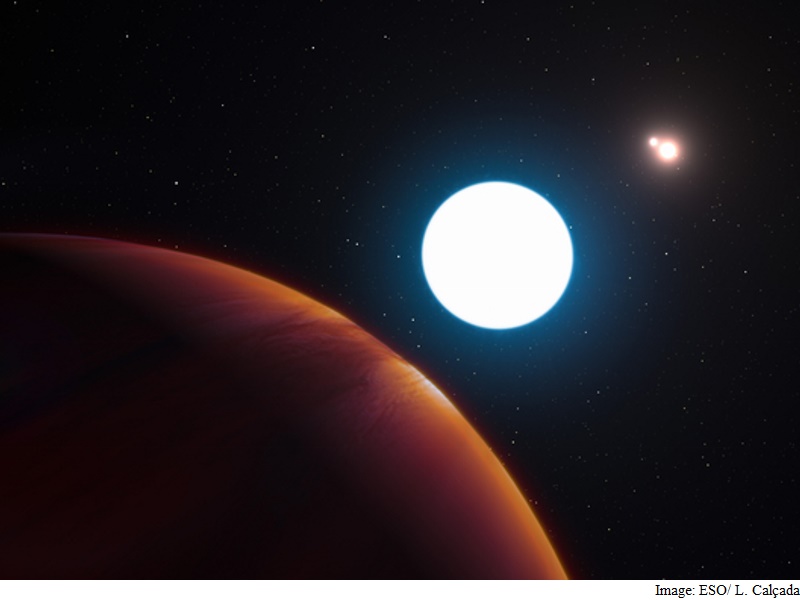- Home
- Science
- Science News
- Astronomers Spot Giant Planet That Experiences Triple Sunrises and Sunsets
Astronomers Spot Giant Planet That Experiences Triple Sunrises and Sunsets

The findings, published on Thursday in the journal Science, challenge current notions about what makes a planetary system viable.
With three stars in the system, the massive planet would experience triple sunrises and triple sunsets during one season and all daylight in another. Since the planet's orbit is very long, each season lasts for hundreds of years.
"Depending on which season you were born in, you may never know what nighttime is like," lead researcher Kevin Wagner of the University of Arizona said.
The planet, called HD 131399Ab, is about four times bigger than Jupiter, the largest planet in our solar system, and is orbiting in a three-star system located about 340 light-years from Earth in the constellation Centaurus.
Scientists are not sure how HD 131399Ab came to exist. It orbits its parent star about twice as far as Pluto circles the sun, needing 550 years to complete a single orbit.
Astronomers have previously discovered planets in multi-star systems, but never one that circles a parent star with such a wide berth. It also is one of the few extrasolar planets - those outside our solar system - to be directly imaged by telescope.
The planet's orbit is akin to the distance more typically seen when a star orbits another star, not a planet orbiting a star.
"This is the first planet that we've found with an orbit that is comparable to that of the stars," Wagner said.
If HD 131399Ab's orbit was just a bit wider, computer simulations show it could be gravitationally elbowed out of the system by the pair of smaller stars that orbit each other and the main star, which is about 80 percent bigger than the sun.
Though the planet is relatively young, around 16 million years old compared to the 4.5-billion-year-old Earth, it likely has had an eventful life. Scientists suspect it may have started off in a much closer orbit around two parent stars before it was gravitationally bounced to its extreme distance.
Scientists plan additional observations to determine if the planet's orbit is actually stable.
"It is not clear how this planet ended up on its wide orbit in this extreme system ... but it shows there is more variety out there than many would have deemed possible," Wagner said.
The planet was detected using the European Southern Observatory's Very Large Telescope in northern Chile.
© Thomson Reuters 2016
For the latest tech news and reviews, follow Gadgets 360 on X, Facebook, WhatsApp, Threads and Google News. For the latest videos on gadgets and tech, subscribe to our YouTube channel. If you want to know everything about top influencers, follow our in-house Who'sThat360 on Instagram and YouTube.
Related Stories
- Samsung Galaxy Unpacked 2025
- ChatGPT
- Redmi Note 14 Pro+
- iPhone 16
- Apple Vision Pro
- Oneplus 12
- OnePlus Nord CE 3 Lite 5G
- iPhone 13
- Xiaomi 14 Pro
- Oppo Find N3
- Tecno Spark Go (2023)
- Realme V30
- Best Phones Under 25000
- Samsung Galaxy S24 Series
- Cryptocurrency
- iQoo 12
- Samsung Galaxy S24 Ultra
- Giottus
- Samsung Galaxy Z Flip 5
- Apple 'Scary Fast'
- Housefull 5
- GoPro Hero 12 Black Review
- Invincible Season 2
- JioGlass
- HD Ready TV
- Laptop Under 50000
- Smartwatch Under 10000
- Latest Mobile Phones
- Compare Phones
- Moto G15 Power
- Moto G15
- Realme 14x 5G
- Poco M7 Pro 5G
- Poco C75 5G
- Vivo Y300 (China)
- HMD Arc
- Lava Blaze Duo 5G
- Asus Zenbook S 14
- MacBook Pro 16-inch (M4 Max, 2024)
- Honor Pad V9
- Tecno Megapad 11
- Redmi Watch 5
- Huawei Watch Ultimate Design
- Sony 65 Inches Ultra HD (4K) LED Smart TV (KD-65X74L)
- TCL 55 Inches Ultra HD (4K) LED Smart TV (55C61B)
- Sony PlayStation 5 Pro
- Sony PlayStation 5 Slim Digital Edition
- Blue Star 1.5 Ton 3 Star Inverter Split AC (IC318DNUHC)
- Blue Star 1.5 Ton 3 Star Inverter Split AC (IA318VKU)

















